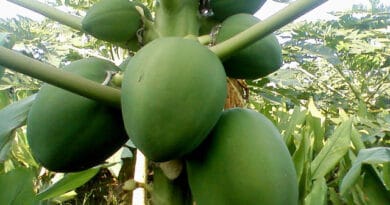Cultivation of Aonla/Amla or Indian Goose Berry
Aonla is indigenous to the Indian Subcontinent and belongs to the family Euphorbiaceae. It is known for its medicinal and therapeutic properties and is considered a wonder fruit for the health-conscious population. It has been grown and known in India for 3500 years. It finds a special mention in the ancient Indian text ‘Ayurveda’ by Sushruta, the father of ancient medicine (during 1500 BC- 1300 BC). The fruit is one of the richest sources of vitamin C, with a higher vitamin C content than that of the guava and citrus fruits.
The tree is characterized by small leaves which are attached to branches in such a way that each branchlet appears to be a compound leaf. The trees attain a height of up to 18 meters. It is such a fruit where there is the least problem of theft, and plants are also very hardy and do not require much care and attention. There is a good crop every year, which results in a high return.
Different Vernacular Names of Alona:
Language | Names |
Hindi | Alma or Aonla |
Sanskrit | Dhatriphala, Amalaki |
Bengali & Oriya | Amla or Amalaki |
Malayalam & Tamil | Nelli |
Telugu | Amlakamu, Usirikai, Usirika |
Punjabi | Amolphal |
English | Aonla, Myrobalan, Indian gooseberry |
Benefits of Aonla Fruit:
- Aonla is the richest source of vitamin C (700 mg per 100 g of fruits). The vitamin C value of aonla increases after its juice extraction from the fruit.
- The dehydrated Aonla fruit provides 2428 to 3470 mg of vitamin C per 100 g.
- Dried powder of aonla fruit possesses 1780–2660 mg of vitamin C.
- The only fruit contains a chemical substance known as leuco anthocyanins (Polyphenol), which retards the oxidation of vitamin C.
- It is an important medicinal plant in Ayurveda. Aonla is the main ingredient of the many ayurvedic medicine products like Chyawanprash, Triphala churna (a mixture of Amla, Terminalia chebula, and T. bellerica), Brahma Rasayana, and Madumegha churna.
The Important Benefits of Aonla are…
1. Aonla juice is a powerful home remedy for treating cough, flu, and mouth ulcers.
2. Regular consumption of Aonla juice helps in reducing cholesterol levels. Amino acids and antioxidants aid in the overall functioning of the heart.
3. It is also helpful in managing diabetes better as well as respiratory ailments like asthma.
4. The alkaline nature of aonla helps in strengthening the digestive system.
5. It supports liver function and flushes out toxins from the body.
6. Along with Vitamin C, amla is rich in iron, calcium, and phosphorus and hence can be taken as a complete nutritional drink.
7. Aonla helps in hair growth, tackling hair fall and fortifying the root as well as the shaft.”
8. Aonla juice helps in oxidizing melanin and closes skin pores.
Varieties of Aonla:
Varieties that are in a bigger size of fruits and are fiberless are considered the best varieties of aonla. They are——-
Banarasi, Chakiya, Francis, or Hathijhool. Krishna (NA-4) and Kanchan (NA- 5), NA-6, NA-7, NA-8, NA-9, NA-10.
Soil and Climate Requirements for Aonla Cultivation
Propagation of Aonla
Seedlings, grafts, and Buddings are used for planting. But it can be commercially multiplied by the patch budding technique, which has been found easy and successful. The best time for budding is from June to August. However, budding may also be done during February or March. Shield or ‘T’ budding is also successful.
Planting of Aonla ;
The best time of Aonala planting is the rainy season. Plants are planted 6-8 meters apart both ways in the pits of 1x1x1 or 1.25 x 1.25 x 1.25 x 1.25 meters size.
Manuring in Aonla;
A dose of 100 g N, 50 g P, and 75 g K/plant/year of age should be applied. In addition, well-rotted compost at the rate of 20–25 kg/plant should be added.
Compost, or F.Y.M., should be added along with half doses of fertilizers during August-September, whereas the remaining dose of fertilizers should be applied in April-May.
Flowering and Fruiting
Budded plants start flowering after 7-8 years of planting. Flowering takes place on new growth during the spring season. Male and female flowers are found separately. Male flowers are much more numerous than female. After fruiting, the embryo remains dormant till August; the fruits are not visible on the tree during this period. Fruit development starts thereafter and matures in December-January.
Sometimes, the problem of unfruitfulness is noticed due to a very low number of female flowers and self-sterility. Such problems can be overcome by intervarietal plantation to facilitate the fertilization process.
Intercropping in Aonla orchards.
The yield of the Aonla plant.
Aonla plants start bearing fruit after two years of planting. A yield of 2-3 quintals may be obtained from a grown-up tree. The average weight of fruit is 60-70 gms. A mature aonla may bear fruit up to the age of 70.
Read Further;
Cultivation of Lime and Lemon (Kagzi ) for Good Income Returns



